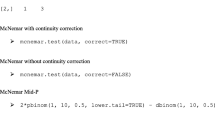Abstract
Experiments using cell cultures are only valid to the extent that the cell culture is a true model system for the biological system being investigated. To assure that a cell line is and remains an appropriate biological model, its identity, purity, ploidy, and phenotype must be maintained. These characteristics comprise and determine the authenticity of a cell line. Routine monitoring of the cell line through microscopic examination of morphology can help to determine authenticity, as can the determination of phenotypic status. Assays designed to confirm cell identity and ploidy and freedom from cross-contaminating cell types may need to be performed at certain times, as such information may not be obtained through morphologic and phenotypic examinations alone. The best practices associated with establishing cell line authenticity are described in this article.





Similar content being viewed by others
References
Allen M, Bjerke M, Edlund H, Nelander S, Westermark B (2016) Origin of the U87MG glioma cell line: good news and bad news. Sci Transl Med 8:354re3
Almeida J, Steffen CR, Cole KD (2011) Authentication of African green monkey cell lines using human short tandem repeat markers. BMC Biotechnol 11:102–112
Almeida JL, Hill CR, Cole KD (2014) Mouse cell line authentication. Cytotechnology 66(1):133–147
ATCC SDO ASN-0002 (2012) Authentication of human cell lines: standardization of STR profiling. ANSI/ATCC ASN-0002-2012
ATCC SDO ASN-0003 (2015) Species-level identification of animal cells through mitochondrial cytochrome c oxidase subunit 1 (CO1) DNA barcodes. ANSI/ASN-0003-2015
Baust JM, Buehring GC, Campbell LH, Elmore E, Harbell JW, Nims RW, Price P, Simione F, Reid YA(2017) Best practices in cell culture: an overview. In Vitro Cell Dev Biol—Anim 53:669–672
Berger B, Berger C, Hecht W, Hellmann A, Rohleder U, Schleenbecker U, Parson W (2014) Validation of two canine STR multiplex-assays following the ISFG recommendations for non-human DNA analysis. FSI Genet 8(1):90–100
Cooper JK, Sykes G, King S, Cottrill K, Ivanova N, Hanner R (2007) Species identification in cell cultures a two-pronged molecular approach. In Vitro Cell Dev Biol - Anim 43:344–351
Didion JP, Buus RJ, Naghashfar Z, Threadgill DW, Morse HC, Pardo-Manuel de Villena F (2014) SNP array profiling of mouse cell lines identifies their strains of origin and reveals cross-contamination and widespread aneuploidy. BMC Genomics 15(1):2–11
Fang R, Shewale JG, Nguyen VT, Cardoso H, Swerdel M, Hart RP, Furtado MR (2011) STR profiling of human cell lines: challenges and possible solutions to the growing problem. J Forensic Res S2:005. https://doi.org/10.4172/2157-7145.S2-005
Frattini A, Fabbri M, Valli R, De Paoli E, Montalbano G, Gribaldo L, Pasquali F, Maserati E (2015) High variability of genomic instability and gene expression profiling in different HeLa clones. Sci Rep 5:15377
Hayflick L (1965) The limited in vitro lifetime of human diploid cell strains. Exp Cell Res 37:614–621
International Cell Line Authentication Committee (2017) Register of misidentified cell lines. http://iclac.org/databases/cross-contaminations/
Kleensang A, Vantangoli MM, Odwin-DaCosta S, Andersen ME, Boekelheide K, Bouhifd M, Fornace AJ Jr, Li H-H, Livi CB, Madnick S, Maertens A, Rosenberg M, Yager JD, Zhao L, Hartung T (2016) Genetic variability in a frozen batch of MCF-7 cells invisible in routine authentication affecting cell function. Sci Rep 6:28994
Liang-Chu MMY, Yu M, Haverty PM, Koeman J, Ziegle J, Lee M, Bourgon R, Neve R (2015) Human biosample authentication using the high-throughput, cost-effective SNPtraceTM system. PLoS One 10(2):e0116218. https://doi.org/10.1371/journal.pone.0116218
Masters JR, Thompson JA, Daly-Burns B, Reid YA, Dirks WG, Packer P, Toji LH, Ohno T, Tanabe H, Arlett CF, Kelland LR, Harrison M, Virmani A, Ward TH, Ayres KL, Debenham PG (2001) Short tandem repeat profiling provides an international reference standard for human cell lines. Proc Natl Acad Sci—USA 98(14):8012–8017
Nims RW, Herbstritt CJ (2005) Cell line authentication using isoenzyme analysis. BioPharm Int 18:76–82
Nims RW, Price P (2017) Best practices for detecting and mitigating the risk of cell culture contaminants. In Vitro Cell Dev Biol – Anim, in press
Reid Y, Storts D, Riss T, Minor L (2013) Authentication of human cell lines by STR DNA profiling analysis. In: Sittampalam GS, Coussens NP, Brimacombe K, Grossman A, Arkin M, Auld D, Austin C, Baell J, Bejcek B, Chung TDY, Dahlin JL, Devanaryan V, Foley TL, Glicksman M, Hall MD, Hass JV, Inglese J, Iversen PW, Kahl SD, Kales SC, Lal-Nag M, Li Z, McGee J, McManus O, Riss T, Trask OJ Jr, Weidner JR, Xia M, Xu X (eds) Assay guidance manual. Bethesda. Eli Lilly & Company and the National Center for Advancing Translational Sciences, Maryland, pp 1–22
Scott MA, Nguyen VT, Levi B, James AW (2011) Current methods of adipogenic differentiation of mesenchymal stem cells. Stem Cells Dev 20:1793–1804
Vogel G (2010) To scientist’s dismay, mixed-up cell lines strike again. Science 329:1004
Wang Y, McIntyre C, Mittar D (2011) Cell cycle and DNA content analysis using the BD Cycletest assay on the BD FACSVerse™ system. BD Sciences Application Note, 1–11 https://www.bdbiosciences.com/documents/BD_Instruments_FACSVerse_CellCycle_DNA_Analysis_AppNote.pdf
Acknowledgements
The authors acknowledge the input and expert review of the following members of the Best Practices in Cell Culture Workgroup: John M. Baust, Gertrude Case Buehring, Lia H. Campbell, Eugene Elmore, John W. Harbell, Paul Price, and Frank Simione.
Author information
Authors and Affiliations
Corresponding author
Additional information
Editor: Tetsuji Okamoto
Rights and permissions
About this article
Cite this article
Nims, R.W., Reid, Y. Best practices for authenticating cell lines. In Vitro Cell.Dev.Biol.-Animal 53, 880–887 (2017). https://doi.org/10.1007/s11626-017-0212-8
Received:
Accepted:
Published:
Issue Date:
DOI: https://doi.org/10.1007/s11626-017-0212-8




